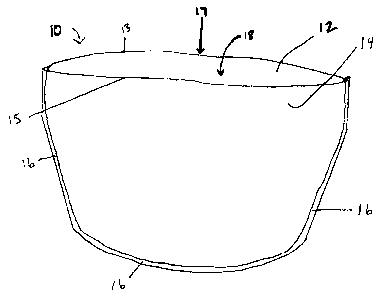Some of the information on this Web page has been provided by external sources. The Government of Canada is not responsible for the accuracy, reliability or currency of the information supplied by external sources. Users wishing to rely upon this information should consult directly with the source of the information. Content provided by external sources is not subject to official languages, privacy and accessibility requirements.
Any discrepancies in the text and image of the Claims and Abstract are due to differing posting times. Text of the Claims and Abstract are posted:
| (12) Patent Application: | (11) CA 2360104 |
|---|---|
| (54) English Title: | PAN LINER |
| (54) French Title: | DOUBLURE DE NACELLE |
| Status: | Deemed Abandoned and Beyond the Period of Reinstatement - Pending Response to Notice of Disregarded Communication |
| (51) International Patent Classification (IPC): |
|
|---|---|
| (72) Inventors : |
|
| (73) Owners : |
|
| (71) Applicants : |
|
| (74) Agent: | NORTON ROSE FULBRIGHT CANADA LLP/S.E.N.C.R.L., S.R.L. |
| (74) Associate agent: | |
| (45) Issued: | |
| (22) Filed Date: | 2001-10-24 |
| (41) Open to Public Inspection: | 2002-04-24 |
| Examination requested: | 2006-10-24 |
| Availability of licence: | N/A |
| Dedicated to the Public: | N/A |
| (25) Language of filing: | English |
| Patent Cooperation Treaty (PCT): | No |
|---|
| (30) Application Priority Data: | ||||||
|---|---|---|---|---|---|---|
|
A contoured pan liner and method of making a pan liner is provided, the pan
liner including a first liner side panel having a first upper edge; a second
liner side
panel having a second upper edge; and at least one scam joining the first and
second
side panels, the first side panel, second side panel and at least one seam
forming an
interior region having an opening along the first and second upper edges, and
wherein
at least a portion of the at least one scam defines an arcuate path along at
least a lower
portion of the interior region.
Note: Claims are shown in the official language in which they were submitted.
Note: Descriptions are shown in the official language in which they were submitted.

2024-08-01:As part of the Next Generation Patents (NGP) transition, the Canadian Patents Database (CPD) now contains a more detailed Event History, which replicates the Event Log of our new back-office solution.
Please note that "Inactive:" events refers to events no longer in use in our new back-office solution.
For a clearer understanding of the status of the application/patent presented on this page, the site Disclaimer , as well as the definitions for Patent , Event History , Maintenance Fee and Payment History should be consulted.
| Description | Date |
|---|---|
| Application Not Reinstated by Deadline | 2010-09-20 |
| Inactive: Dead - No reply to s.30(2) Rules requisition | 2010-09-20 |
| Deemed Abandoned - Failure to Respond to Maintenance Fee Notice | 2009-10-26 |
| Inactive: Abandoned - No reply to s.30(2) Rules requisition | 2009-09-18 |
| Inactive: S.30(2) Rules - Examiner requisition | 2009-03-18 |
| Letter Sent | 2006-11-07 |
| All Requirements for Examination Determined Compliant | 2006-10-24 |
| Request for Examination Requirements Determined Compliant | 2006-10-24 |
| Request for Examination Received | 2006-10-24 |
| Inactive: IPC from MCD | 2006-03-12 |
| Inactive: IPC from MCD | 2006-03-12 |
| Inactive: Office letter | 2006-01-09 |
| Inactive: Delete abandonment | 2006-01-06 |
| Deemed Abandoned - Failure to Respond to Maintenance Fee Notice | 2005-10-24 |
| Letter Sent | 2002-05-23 |
| Application Published (Open to Public Inspection) | 2002-04-24 |
| Inactive: Cover page published | 2002-04-23 |
| Amendment Received - Voluntary Amendment | 2002-04-03 |
| Inactive: Single transfer | 2002-04-03 |
| Inactive: First IPC assigned | 2002-01-04 |
| Inactive: IPC assigned | 2002-01-04 |
| Inactive: Courtesy letter - Evidence | 2001-11-13 |
| Inactive: Filing certificate - No RFE (English) | 2001-11-08 |
| Filing Requirements Determined Compliant | 2001-11-08 |
| Application Received - Regular National | 2001-11-08 |
| Abandonment Date | Reason | Reinstatement Date |
|---|---|---|
| 2009-10-26 | ||
| 2005-10-24 |
The last payment was received on 2008-10-15
Note : If the full payment has not been received on or before the date indicated, a further fee may be required which may be one of the following
Patent fees are adjusted on the 1st of January every year. The amounts above are the current amounts if received by December 31 of the current year.
Please refer to the CIPO
Patent Fees
web page to see all current fee amounts.
| Fee Type | Anniversary Year | Due Date | Paid Date |
|---|---|---|---|
| Application fee - standard | 2001-10-24 | ||
| Registration of a document | 2002-04-03 | ||
| MF (application, 2nd anniv.) - standard | 02 | 2003-10-24 | 2003-10-08 |
| MF (application, 3rd anniv.) - standard | 03 | 2004-10-25 | 2004-10-06 |
| MF (application, 4th anniv.) - standard | 04 | 2005-10-24 | 2005-10-24 |
| MF (application, 5th anniv.) - standard | 05 | 2006-10-24 | 2006-10-24 |
| Request for examination - standard | 2006-10-24 | ||
| MF (application, 6th anniv.) - standard | 06 | 2007-10-24 | 2007-10-02 |
| MF (application, 7th anniv.) - standard | 07 | 2008-10-24 | 2008-10-15 |
Note: Records showing the ownership history in alphabetical order.
| Current Owners on Record |
|---|
| CONNECTICUT PACKAGING MATERIALS INC. |
| Past Owners on Record |
|---|
| LAWRENCE GREENFIELD |
| MICHAEL L. GREENFIELD |